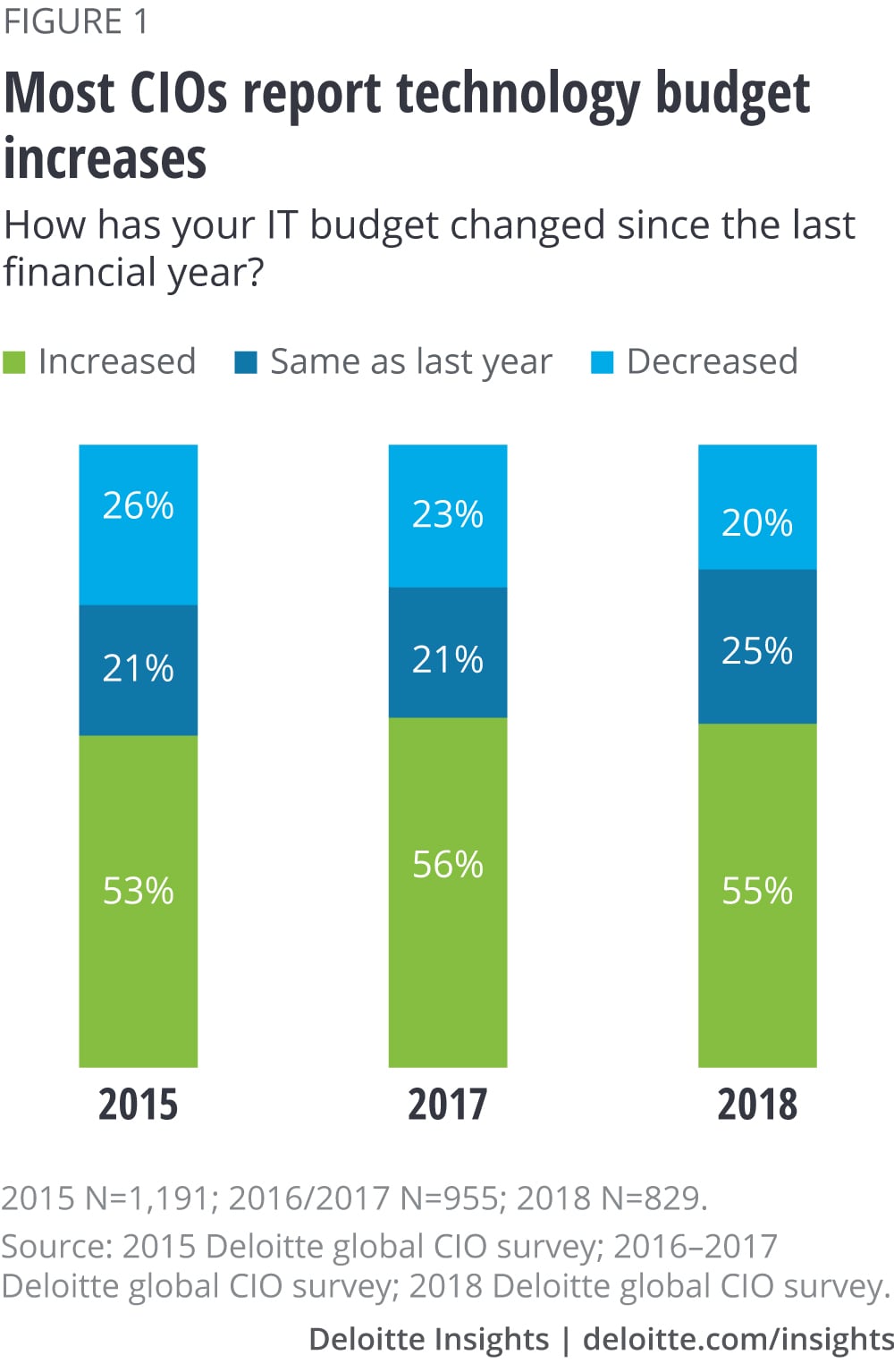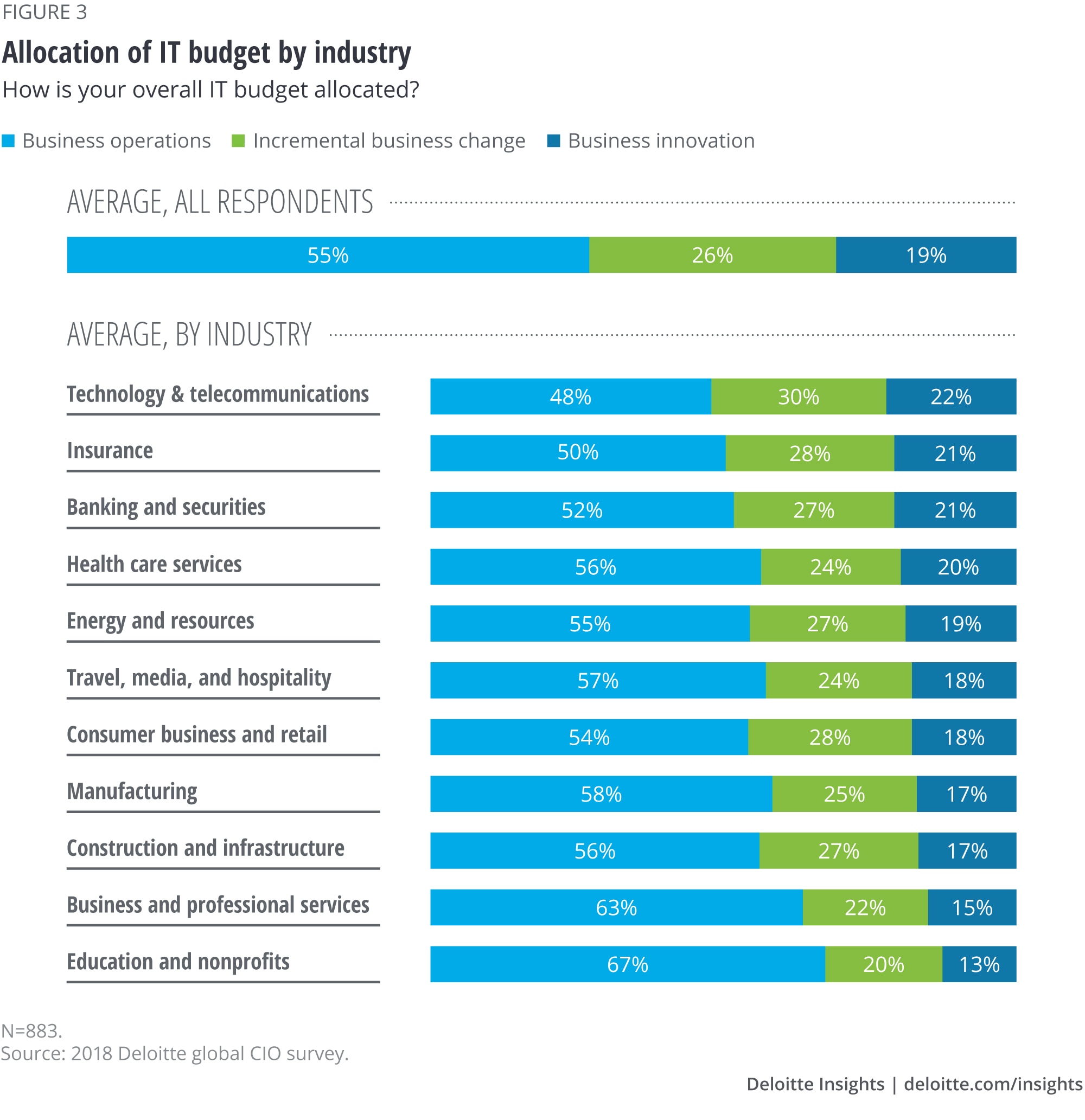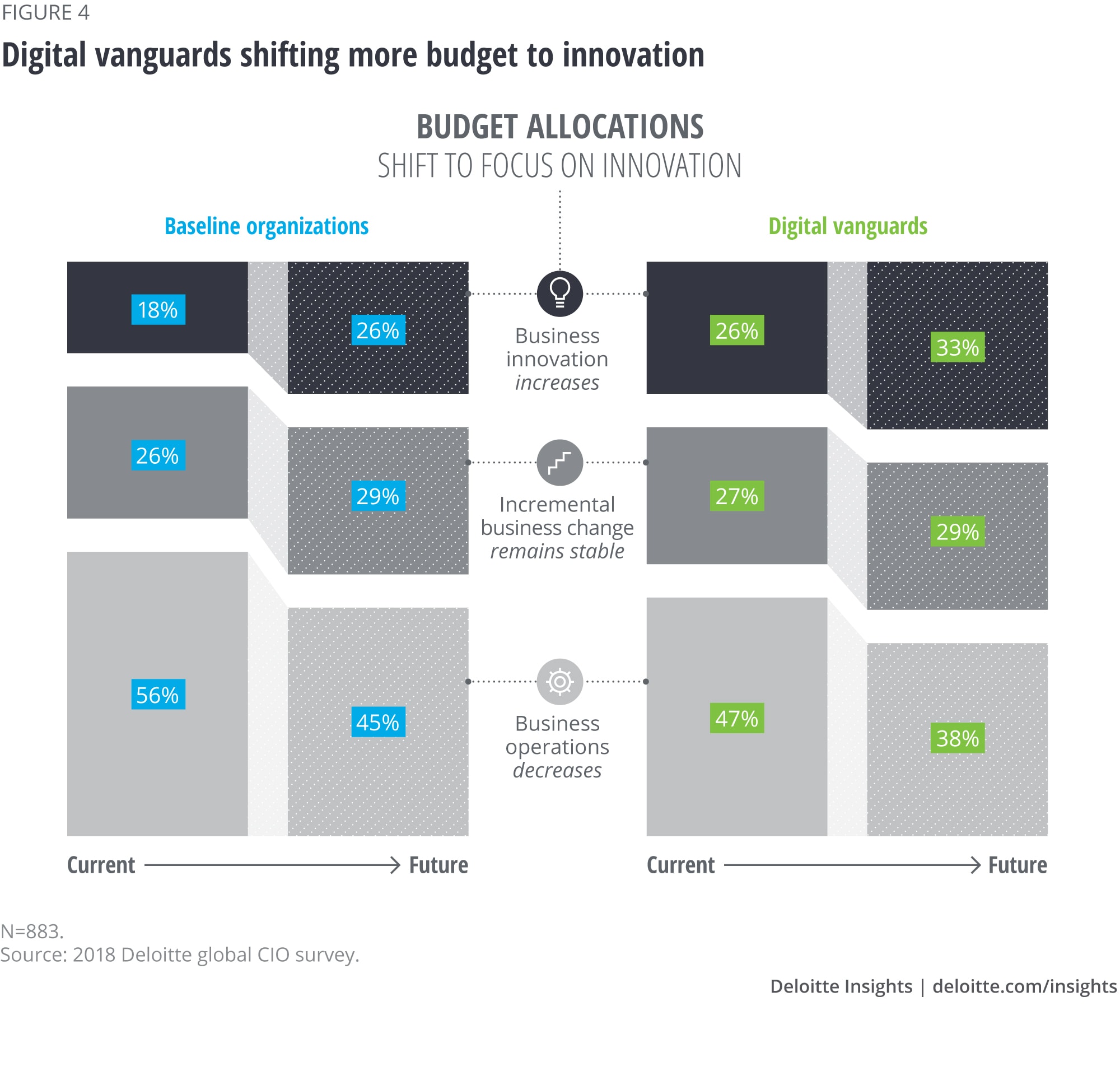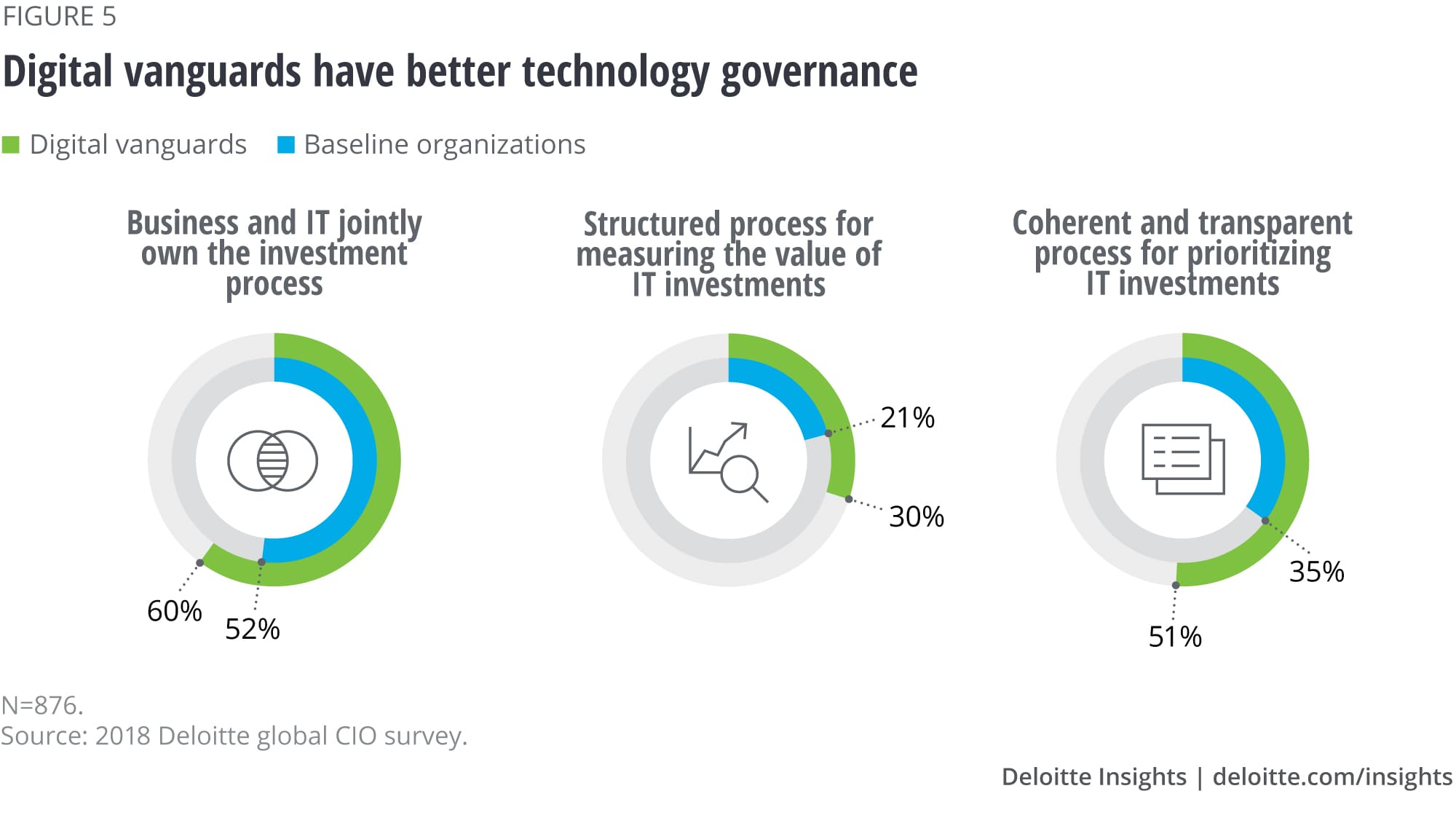
Reinventing tech finance: The evolution from IT budgets to technology investments CIO Insider
9 minute read
07 January 2020
While technology is quickly transforming the nature of business, technology investment processes have not always kept pace. How can CIOs rethink traditional technology budgeting?
Technology plays a central role in helping companies develop and capitalize on new business models. As the role of technology shifts, budgets and the investment process are subject to increased scrutinization—and are ripe for evolution.
Learn more
Explore the CIO Insider collection
Download the Deloitte Insights and Dow Jones app
Subscribe to receive related content from Deloitte Insights
This CIO Insider uncovers trends in technology budgets and examines the spending habits of companies that are more advanced than their peers. It also explores the impact of IT operating model changes on technology funding and makes recommendations for rethinking the traditional technology budgeting process.
Evolution of technology spending
Reflecting the importance of technology and its role in value creation, the majority of companies have consistently experienced budget increases over the last four years, according to participants in Deloitte’s ongoing series of global CIO surveys (figure 1). Still, a considerable percentage of participants continue to report budgets are decreasing or remaining the same.

IT budget as a percentage of revenue—a time-tested benchmark that’s useful for comparing industries—ranges from nearly 8 percent in banking and securities to less than 2 percent in construction and manufacturing, with an average of 3.64 percent for all industries (figure 2).1
As technology and business strategies merge, IT’s emphasis on service delivery is giving way to a focus on value delivery. Maintaining business operations is still critical, but it’s equally important for technology teams to work hand-in-hand with business functions to cocreate value.
Yet many CIOs describe a significant gap between business leadership’s expectations of IT and corresponding financial support.2 Seventy-two percent of CIOs say projects that are most appealing to CEOs and executive leadership are those that generate revenue or focus on innovation and emerging technology.3

Yet the average IT department invests more than half (55 percent) of its technology budget on maintaining business operations and only 19 percent on building innovative new capabilities.4 Industry differences exist; for example, technology and telecommunications, insurance, and banking and securities companies are spending more on innovation as they rapidly build new business capabilities and engage customers. Similarly, healthcare and energy companies have historically lagged in technology spending but are now investing more in innovation as their industries go through technology transformations (figure 3).

Digital vanguards lead in technology investments
The latest CIO survey found that organizations identified as more digitally advanced, known as digital vanguards, have four spending habits that distinguish them from their peers, known as baseline organizations.
- They spend more on innovation. Digital vanguards tend to spend a higher percentage of their budgets on innovation. On average, they allocate 26 percent to innovation and less than half (47 percent) to business operations, compared to baseline organizations, who allocate only 18 percent to innovation and 56 percent to business operations. In the next three to five years, both digital vanguards and baseline organizations plan to further reduce operations spending while increasing innovation budgets—but digital vanguards project that spending on operations (38 percent) and innovation (33 percent) will come closer to parity (figure 4).

- They spend twice as much on technology. Digital vanguards’ IT budgets are a much larger percentage of revenue (6.35 percent) when compared to baseline organizations (3.38 percent).5 On average, digital vanguards are more likely than baseline organizations to have had an annual increase in technology budgets. Fifty-eight percent of digital vanguards say their IT budgets increased in the last financial year, compared to only 51 percent of baseline organizations.6
- They practice better technology governance. IT-business alignment is uncommon among both digital vanguards and baseline organizations, but digital vanguards are a little ahead of their peers, particularly when it comes to prioritizing and making decisions about technology funding. Only 52 percent of baseline organizations have a technology investment decision-making process jointly owned by IT and the business; 60 percent of digital vanguards do. Among baseline organizations, only 35 percent have a clear process for prioritizing IT investments, compared to about half (51 percent) of digital vanguards (figure 5).

- They use metrics more effectively. Digital vanguards are better than baseline organizations at measuring the value and impact of technology investments, although both groups have room to improve. Digital vanguards are less likely (48 percent) than baseline organizations (67 percent) to measure results on an ad hoc basis and more likely (28 percent compared to 18 percent) to use dashboards or scorecards to communicate benefits and costs. In addition, as shown in figure 6, they’re more likely to hold business leaders responsible for measuring the value of an investment (35 percent) than baseline organizations (24 percent), which can help improve business accountability. Surprisingly, 14 percent of all organizations—15 percent of baseline organizations and 10 percent of digital vanguards—say they don’t measure the impact of IT investments at all. 7

Shifting mindset from cost to investment
CIOs have long been challenged by the perception of IT as a cost center. The merger of technology and business strategies can give CIOs the opportunity to swap out an emphasis on reducing costs, for an investment mindset that prizes strategic spending to increase revenue, growth, stock price, or other measurements of business and shareholder value.
As the technology function takes on a more high-profile role, CIOs may need to address important considerations regarding core modernization, cloud business models, investment governance and value measurement, incompatibility of fixed budgets with Agile development, and automation’s impact on the workforce.
Complex choices about core modernization. Many CIOs recognize that legacy core systems lack the agility needed to develop and scale innovative and disruptive new technology solutions—more than a third (34 percent) identify the complexity of technology systems and environments as the top contributor to project failure.8 Gartner predicts that through 2020, for every dollar invested in digital business innovation, enterprises will need to spend at least three times as much to continuously modernize the legacy application portfolio.9
That could be why 43 percent of CIOs say core modernization is the technology area expected to have the most impact on the business in the next three years.10 Organizations saddled with legacy systems can rehost, replatform, rearchitect, rebuild, or replace them—strategies that vary in impact, cost, risk, and value.
But core modernization should be evaluated as a technology investment alongside other investment choices. The CIO of a large distribution company decided to hold off on a modernization effort and redirected the funds to a custom warehouse management application that gave the organization a competitive advantage. The return on investment (ROI) of the warehouse management system was much higher than that of the modernization effort.11
Impact of cloud business models on opex/capex. Lured by ease of use and deployment, business and technology functions have embraced cloud solutions with open arms: Ninety percent of CIOs surveyed say their organizations are using cloud-based services.12
The cloud can drive innovation and encourage experimentation because it eliminates the burden of buying and maintaining technology infrastructure. Seventy-five percent of survey respondents say they use cloud services because they increase scalability, which can be important where market demand is uneven, uncertain, or volatile. Nearly as many (72 percent) say it improves business agility, allowing for faster time to market. For these and other reasons, CIOs surveyed spend an average of 22 percent of the IT budget on cloud-based services, an amount they expect to double (44 percent) in the next three years.13
But every investment has risks, and cloud is no different. Because cloud shifts technology investments from the capital expense column to the operating expense column, moving to cloud too quickly could substantively impact company financials. Finance and technology functions can work together to classify these costs appropriately and assess and optimize the impact of cloud investments. Many CIOs and CFOs are already employing strategies for depreciation and capital allocation to offset this impact.
Other risks associated with widespread adoption of cloud and software-as-a-service (SaaS) business models are the ungoverned adoption of cloud services and improper management and oversight of cloud investments, which can occur in the absence of a strong governance process for procuring cloud services. This can leave companies at risk for cloud sprawl—the unplanned, uncontrolled proliferation of disparate, and sometimes duplicate, cloud services across an enterprise.14 Cloud sprawl can impact technology budgets by increasing operational complexity and creating unchecked cloud consumption.
Consistent investment governance and value measurement. Appropriate oversight of technology spending can help CIOs, CFOs, and other executives prioritize technology investments, align with corporate strategy, and ensure transparency. Yet, only a little more than a third of survey participants (37 percent) say they manage investments using well-defined processes or business case templates.15
Similarly, IT and business alignment on budgeting is uncommon. Thirty-six percent of CIO survey participants report a lack of business ownership and accountability as the top challenge in securing funding. And as previously discussed, most organizations have not fully embraced a joint IT-business function ownership of technology investment decision-making and measurement processes (figures 5 and 6).16
Technology leaders can strengthen the ability to build credible business cases that accurately forecast technology project ROI and evaluate the performance and value of each investment. A dedicated finance staff tasked with modeling, managing, and measuring the value of IT investments can be helpful, but only 20 percent of CIO survey participants report having such a person on their staff.17
Taking such steps can help reduce the perception that the technology function is an inscrutable black box, make it easier for technology leaders to justify expenditures, and help them build stronger relationships with CFOs.
Incompatibility of fixed budgets with Agile development. Agile and other flexible delivery styles are on the rise—the CIO survey found that 56 percent of CIOs expect to implement Agile, DevOps, or a similar flexible IT delivery model to increase IT responsiveness.18
But these efforts could be stymied by traditional budgeting processes, which aren’t optimized for the Agile development environment. Rather than promoting cross-functional teaming, iterative sprints, and the customer- and product-oriented mindset—the hallmarks of Agile development—fixed IT budgets are typically structured to provide incremental annual increases and encourage functional silos, inflexible requirements, and a project-focused mindset. Agile’s laissez-faire approach to project scope and requirements dictates more flexible timelines, processes, and financing, which fly in the face of the fixed annual budget’s insistence on predictable costs and resources.
CIOs can manage the investment portfolio in the same manner as venture capitalists, but only if funding models are adjusted to encourage Agile, product-focused environments. A flexible budgeting process can give product teams the creativity and accountability needed to deliver business value.
The impact of automation on the workforce. The ability of automation and robotics to streamline and speed up IT delivery is changing the way technology and business teams work, collaborate, and create value. Nearly three-quarters (72 percent) of CIOs surveyed in Deloitte’s 2019 Industry 4.0 study say autonomous technologies will augment the efforts of human workers, while 28 percent believe that these technologies will increasingly replace human workers.19 Jobs will morph into “superjobs” that merge different aspects of traditional jobs to create integrated roles that take advantage of technology-driven increases in productivity and efficiency.20
As more and more technology work is performed by a mix of humans and machines, technology budgets, as well as the budgeting process, will likely evolve. For example, nearly half of the CIOs who participated in the Industry 4.0 study (48 percent) say that over the next five years, their organizations plan to significantly increase hiring of gig workers, which could result in significant changes to talent funding.21 And as automation enables teams to trade manual and repetitive tasks for those requiring higher-order skills, better workflows and different resource requirements could drive up productivity, output, and reduce operational costs and errors.
Key recommendations: Seven principles of sound investing
These seven principles can serve as the foundation of a sound technology investment decision-making process.
- Know the business strategy. In interviews, many CIOs say they struggle to articulate technology’s role—and a corresponding investment plan—without a coherent business strategy. A joint business-technology strategy can help clarify the role of technology in driving business value and provide a transformation agenda that can inform the organization’s technology investment strategy.22
- Focus on company financials. Every company tracks critical financial metrics—including value growth, market share, ROI, earnings per share, profitability, margins, and revenue—depending on business context and industry and market conditions. Informed investment decisions likely require an understanding of technology’s impact on these key performance indicators (KPIs). ROI is typically the most important financial metric: Every technology investment should have a calculated and preferably tangible return. Business leaders, especially CFOs, tend to view technology investments as a capital allocation problem: In which asset should they invest capital? The decision depends on the comparative return on this capital.
- Build a balanced portfolio. To cultivate the most diverse set of investments, many CIOs are managing technology portfolios, allocating funding across various time horizons and according to potential risk, reward, and value. Depending on corporate strategy and competitive and market factors, CIOs look for the right balance of technology investments in three areas: existing business operations, business capability enhancements, and adjacent and new capabilities. On average, CIO survey participants currently invest 55 percent, 26 percent, and 19 percent across the three categories, respectively. However, as previously shown in figure 4, these percentages are expected to become comparable in each category over time, especially for leading companies such as digital vanguards.
- Employ risk management tools. Technology leaders can help the organization define and understand its risk appetite, which may vary along with changes in leadership, competitive environment, and other factors. Because every business executive may have a different risk threshold, it’s important to understand and agree on governance principles and evaluation methodologies that are aligned with the collective risk tolerance. Then, define metrics such as margin of safety; ROI and hurdle rates; and long-term investment horizons.
- Expect volatility. Change is happening much faster than ever before, and it’s expected to continue to escalate. To keep pace, technology investments need to be flexible—annual budget cycles, fixed budget allocations, and earmarked budgets can encumber agility and impede quick course corrections. As with any other investment, reevaluating periodically can keep the investments on the right track.
- Keep operational expenses low. Running a tight IT shop with efficient operational expenses can help a CIO build credibility as a seasoned business leader. One high-profile CIO joined a consumer goods company and spent his first two years driving efficiencies and focusing on cost, eventually paring the technology budget by nearly a quarter. This gained him the trust of business leaders, and over time, he was able to transform the IT organization into a growth engine for the company, increasing technology investments by six times the initial budget.23
- Control your destiny. Technology leaders can continue to help run current business operations and invest in efficiency, security, and reliability. Or, they can choose the risky, but rewarding, path of making calculated bets and exploring new technologies and solutions. On the first path, the value delivered today becomes commoditized tomorrow. Following the second path allows them to potentially have a much bigger impact and ultimately take on roles with bigger scope and influence.
© 2021. See Terms of Use for more information.
Read more from CIO Insider
-
Technology and the boardroom: A CIO’s guide to engaging the board Article6 years ago
-
Trends in CIO reporting structure Article6 years ago
-
Technology budgets: From value preservation to value creation Article7 years ago
-
Stepping up: The CIO as digital leader Article7 years ago
-
Bridging the boardroom’s technology gap Article7 years ago
-
Manifesting legacy: Looking beyond the digital era Collection6 years ago










